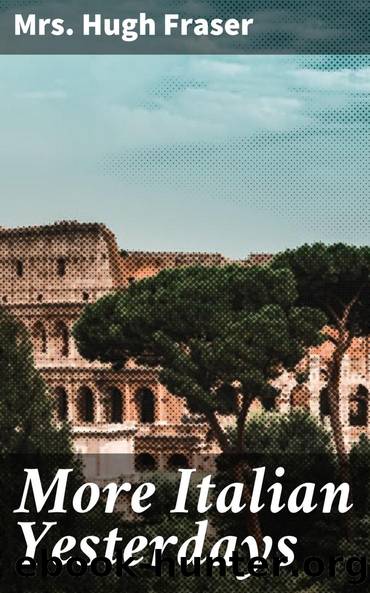Italian Yesterdays, vol. 1 by Fraser Hugh Mrs

Author:Fraser, Hugh, Mrs. [Fraser, Hugh, Mrs.]
Language: eng
Format: epub
Tags: History, Nonfiction
ISBN: 4064066135690
Publisher: Good Press
Published: 2019-12-19T05:00:00+00:00
CHAPTER XI THE CHURCH UNDER CONSTANTINE
Constantineâs EdictâSt. Sylvester, the Friend of ConstantineâRefuge at SoracteâThe Emperorâs VisionââIn Hoc VincesââConstantineâs BaptismâThe Church Has PeaceâHelenaâs BasilicaâThe Blessing of the Golden RoseâOrigin of St. PeterâsâThe Obelisk from HeliopolisâTestimony of the Dust of the MartyrsâThe Place of the Shock of HorsesâThe Beauty of St. PeterâsâPilgrims from BritainâCharlemagne, the Blessed.
âAnd the Church had peace!â Those few words are all that are used to describe the overwhelming relief of the world when Constantine caused his great edict to be proclaimed throughout the Empire. âLet none henceforth dare to molest the Christians in the exercise of their religion or in the building of Temples to God.â
The frightful persecution under Diocletian, more cruel and bloody than all that had preceded it, had been continued by his successor Galerius,[22] and was still active, still a living menace to the faithful; and, as they had done so often during the past three hundred years, they had to fly to their underground refuges or out into the desert to call upon the rocks and mountains to cover them. St. Melchiades, whom St. Augustine calls âthe true son of the Peace of our Lord Jesus Christ,â became Pope in 311 and suffered such great tribulations for the faith in the beginning of his pontificate that the Church reckons him among the martyrs, although he lived to see her triumph, dying only in 313. To him succeeded Sylvester, the great ruler, the friend of Constantine, whose name is so intimately connected with the foundation of the two chief basilicas of Christendom, that of St. John Lateran and that of St. Peterâs.
Before being called to the Papacy, St. Sylvester had been a zealous and holy priest for many years, but during a part of that time he had been obliged to live in hiding on Mount Soracte, the strange rock which raises itself from the Campagna, some twenty-five miles to the northeast of Rome, to culminate in a precipitous cliff two thousand two hundred and seventy feet highâas if arrested by the sight of the distant city. I think it was Byron who compared it to a wave about to break, and no other simile describes it half so well. I spent a heavenly day there in my youth and came away regretfully, not only because of the superb view of the Apennine panorama at which I had been gazing, but because of the ideal aloofness and sweetness of the atmosphere round the ruined convent on the summit, where, though I was then in the first flush of youth, I would gladly have remained for years. Soracte, under its present name, was well known to the Romans; Horace had sung of the mantle of the snow that lay on its rough sides in the winter; Virgil spoke of it reverently as one of the homes of Apollo, who had a temple there; so its name is not a contraction of St. Oreste, as some used to think, though a Church and monastery were dedicated to that saint on Soracte very early in our era.
Download
This site does not store any files on its server. We only index and link to content provided by other sites. Please contact the content providers to delete copyright contents if any and email us, we'll remove relevant links or contents immediately.
Room 212 by Kate Stewart(4731)
The Crown by Robert Lacey(4568)
Endurance: Shackleton's Incredible Voyage by Alfred Lansing(4495)
The Iron Duke by The Iron Duke(4114)
The Rape of Nanking by Iris Chang(4019)
Killing England by Bill O'Reilly(3896)
Joan of Arc by Mary Gordon(3779)
Say Nothing by Patrick Radden Keefe(3725)
I'll Give You the Sun by Jandy Nelson(3269)
Shadow of Night by Deborah Harkness(3169)
Hitler's Monsters by Eric Kurlander(3161)
Mary, Queen of Scots, and the Murder of Lord Darnley by Alison Weir(3060)
Blood and Sand by Alex Von Tunzelmann(3055)
Darkest Hour by Anthony McCarten(3017)
Margaret Thatcher: The Autobiography by Thatcher Margaret(2969)
Eleanor & Park by Rainbow Rowell(2940)
Red Famine: Stalin's War on Ukraine by Anne Applebaum(2814)
Book of Life by Deborah Harkness(2714)
The One Memory of Flora Banks by Emily Barr(2683)
